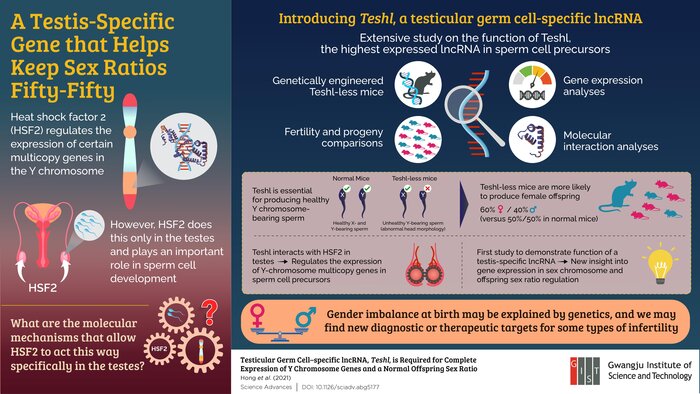
Testis-specific gene involved in sex ratio regulation discovered
Although enormous progress has been made over the past few decades in genetics, molecular biology and biochemistry, the ways in which living beings orchestrate their internal processes at the microscopic scale is still full of mysteries. One clear example of this are long non-coding RNA (lncRNA) molecules, which are a relatively new class of genes that are not translated into proteins yet directly fulfill intriguing functions. While many lncRNA genes have been identified, determining their specific purposes remains a challenge.At Professor Chunghee Cho's lab in the Gwangju Institute of Science and Technology in Korea, a team of scientists has recently discovered a novel lncRNA gene relevant to a crucial topic in life sciences: the regulation of sex ratios for offspring. In their latest study, which was published in Science Advances, the researchers explained how they clarified the function of this testes-specific lncRNA, which they called Teshl, through a series of experiments, which included genetically engineered mice, gene expression analyses, and examination of molecular interactions.First, the team noted that Teshl is expressed at a specific stage during the development of sperm from their precursor cells, particularly when spermatids start elongating to obtain the characteristic 'tadpole' shape of sperm. Then, to gain insight into the function of Teshl, the researchers genetically engineered mice that lacked this gene. They found that about half the sperm cells of these mutant mice had small, malformed, or flat heads, but, surprisingly, this problem only affected sperm cells carrying the Y chromosome. As a result, Y-bearing sperm was less fertile than X-bearing sperm, and the offspring of mutant mice were more likely to be female rather than male.The scientists then delved into the specific effects of Teshl on the expression of other genes. They found that Teshl interacts with a better-known protein called heat shock factor 2 (HSF-2), and activates the expression of multiple genes exclusive to the long stand of the Y chromosome. In turn, these genes are important for the correct development of Y-bearing sperm and the proper regulation of certain X chromosome-specific genes. "Our study is the first to demonstrate a biological function of a testis-specific lncRNA in male reproduction, providing new insights into sex chromosome gene expression and offspring sex-ratio regulation," highlights Ph.D. student Seong Hyeon Hong, the lead author of the study.The overall findings of the study have several important implications in the fields of biology and medicine, as Professor Cho explains: "Our results contribute to the understanding of sex ratio variations and suggest that gender imbalance at birth could be caused by genetics. In turn, this could represent a basis to develop diagnostics and/or therapeutics for human male infertility." While the insights provided are relatively small pieces in the larger puzzle of sexual reproduction at the cellular level, this will surely pave a path to a clearer picture.More information:Seong Hyeon Hong et al, Testicular germ cellspecific lncRNA, Teshl, is required for complete expression of Y chromosome genes and a normal offspring sex ratio, Science Advances (2021). DOI: 10.1126/sciadv.abg5177Provided byGIST (Gwangju Institute of Science and Technology)Citation: Testis-specific gene involved in sex ratio regulation discovered (2021, July 30) retrieved 1 August 2021 from https://phys.org/news/2021-07-testis-specific-gene-involved-sex-ratio.htmlThis document is subject to copyright. Apart from any fair dealing for the purpose of private study or research, no part may be reproduced without the written permission. The content is provided for information purposes only.
……Science
Comments
Leave a comment in Nestia App